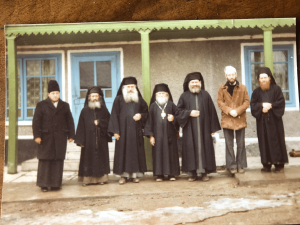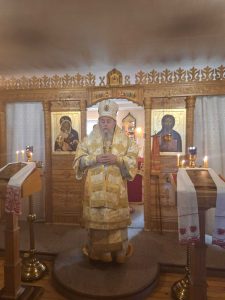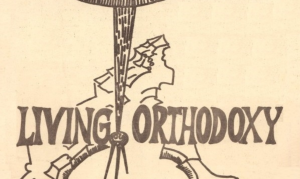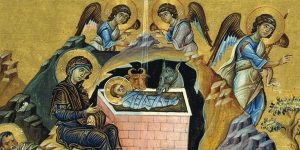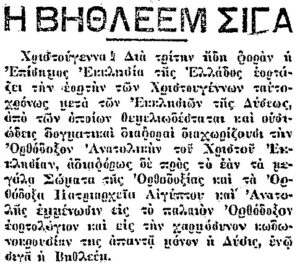The Re-Establisher of the Russian Ecclesiastical Misson in Peking: Metropolitan Innokenty (Figurovsky) of Peking and China
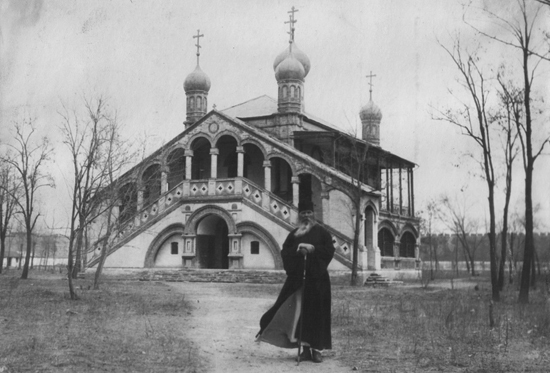

Ivan Apollonovich Figurovich, named Innokenty upon his monastic tonsure, was born on February 24, 1863, in the Yenisei Diocese to the family of a priest. Metropolitan Anthony (Khrapovitsky) of blessed memory wrote that “he led a blameless life in heavy podvig and sought the glory of God, with no regard for himself” (“Bei-Guan,” Tyanzin, 1939, p. 35, author unknown).
In 1878, after completing Krasnoyarsk Seminary, he enrolled in Tomsk Seminary, which he left after four years, in 1882. In 1884, he was ordained to the priesthood and assigned to a church in Derbin, in the Yenisei Diocese, and later transferred to the town of Verkhne-Kuzhebarskoye in the Minusin region. In 1886, he began the fourth-year course of St Petersburg Seminary, which he graduated in 1888. That year he enrolled in St Petersburg Theological Academy, and in 1890, tonsured by Archbishop Anthony (Vadkovsky, +1912) and given the name Innokenty. In 1892, he finished the Academy with a doctorate in theology and appointed Inspector of St Alexander Nevsky Theological School. On May 15, 1893, he was awarded the gold cross. The following year, he was elevated to the rank of archimandrite and appointed Rector of St Petersburg Theological Academy. In 1895, he became the Abbot of the Second-class Pokrovsky Missionary Monastery in Moscow.
On October 3, 1896, Fr Innokenty as appointed Head of the Russian Ecclesiastical Mission in Peking. In accordance with the wishes of the Ober-Procurator of the Holy Ruling Synod, Konstantin Pobedonostsev, in order to familiarize himself with missionary work in the Western countries, he departed Russia and traveled to London, Paris, Rome, Mt Athos, Palestine, Suez, Aden, Colombo, Saigon and Shanghai. He visited missionary institutions, mostly in Europe. On March 1, 1897, he arrived in Tyanzin.
After his arrival in Peking, he came to love the Chinese people with all his heart, the energetic Archimandrite Innokenty established a schedule of daily Liturgies at the mission, and within a year established a typographical shop and bindery, built 5 churches and a cemetery chapel, a mission rest house in Peitaho with a chapel dedicated to the Transfiguration of the Lord and a skete in Tsintantzui. That year, the Holy Synod gave its blessing for the bishop of Vladivostok to ordain two Chinese orthodox priests.
During the Boxer Rebellion of 1900, at the insistence of the Russian ambassador, Fr Innokenty and his colleagues came to the embassy for protection, and had with them the Albazin Icon of St Nicholas of Mozhaisk. All the mission’s churches and buildings, including its great library were destroyed or burned by the haters of the Europeans. The Chinese Christians at the embassy were not spared, and 222 people were killed, and so those who suffered for the faith and the Church received the uncorruptable crowns from God. The future Vladyka Innokenty wrote about them:
“Terrible was their fate. Their stomachs were cut open, heads were chopped off, they burned them in their homes. The Orthodox catechism teacher Pavel Van died a martyric death with prayers on his lips. Iya Ven, a teacher at the missionary school, was tortured by them two times. The first time, the Boxers hacked at her then dumped earth upon her. When she regained consciousness, her moans were heard by a guard (a pagan), and he brought her to his booth. Soon after the Boxers once again seized her and this time tortured her to death. Both times, Iya Ven joyfully witnessed Christ before her tormentors. After the terrible events of the first night, the peaceful Chinese found an 8-year-old boy, Ivan Tzi, the son of a murdered priest who was brutally mutilated by the Boxers: his fingers were cut off and there were wounds on his chest. When they asked the boy if he was in much pain, the boy replied with a smile that suffering for Christ was not difficult. This child martyr was seized, his head cut off and burned in a fire” (Ponomarev, Protopriest Nikolai, Khristiyanstvo na Dal’nem Vostke [Christianity in the Far East], Harbin, Doctoral thesis, 1937, p. 193).
The feast day of the Chinese martyrs is celebrated on June 11/24, when most of them were killed and the Mission destroyed, as was confirmed by the Council of Bishops of the Russian Orthodox Church Outside of Russia in 1996. In 1903, Bishop Innokenty and his clergy and flock ceremoniously transferred their relics to a crypt in a church dedicated to these holy martyrs.
In August, 1900, Fr Innokenty moved with his monastic brethren and a few families to a Laman monastery in Yunhogun, where they lived in a palace once used by Chinese emperors for their fasting days. Here he opened a school with a temporary church. The Mission then moved to Tyantzin, where they settled in houses belonging to General Neshichen. In order to prevent the Mission from being moved to Port Arthur, Fr Innokenty reorganized the mission in Shanghai and bought a parcel of land and a building, in which he set up a chapel, registering it with the US Consulate.
In 1901, Fr Innokenty took to reestablishing the Peking Mission, and as he disseminated the Word of God among the Chinese population, he and his brethren enjoyed the fruits of success in their apostolic efforts, converting 6,000 Chinese people to faith in Christ during a 15-year period (1902-1917).
The blood of martyrs has always been the seed of Christianity, and so it was in China. Credit is due to the success of proselytizing, and other circumstances. The intercession of martyrs before the Throne of God gave strength, wisdom and unflagging courage for the missionary work of those who spread Orthodox Christianity. Everyone who studies the history of this period must praise God, wondrous in His saints, Who by the prayers of the martyrs blessed the missionaries. Their selfless service is worthy of praise, too.
The Chief of the Russian Ecclesiastical Mission, helped by the prayers of the martyrs, restored the destroyed mission headquarters, the churches, buildings, the fine Dormition Monastery, bell tower, print shop (one of the best in China), the book bindery, the rest home with its chapel in Peitaho. He also built new churches: St Seraphim, Dormition, St Nicholas and St Innokenty Churches in Peking; St Vladimir Church in Port Arthur; Annunciation Church in Harbin; Epiphany Church in Shanghai; St Innokenty Missionary Cathedral in Hankow, along with several chapels; St John the Theologian Church in Dundinan and Elevation of the Cross Church in Mantowtsun. He also opened branches of the Mission in Dal’ny, Harbin, Hailar, Manchuria, Moscow and St Petersburg; one seminary, 21 schools, a hospice, a convent in 1903; 30 Mission offices in Tziansua, Tziansie, Hubei, Chesyan and other locales; the Brotherhood of Orthodox Churches in China (during the Russo-Japanese War), which opened a hospital at the Harbin branch and published Izvestia Pravoslavnoi Tserkvi v Kitaje [News of the Orthodox Church in China], and a series of other very profitable endeavors: a dairy farm, an apiary, etc. As a result, Fr Innokenty was able to expand the Russian Ecclesiastical Mission, which by then occupied an enormous block in north-west Peking, and increased its budget to 100,000 gold rubles a year.
Archimandrite Innokenty, traveling to St Petersburg in 1902, learned that the Holy Rulin Synod had desired to close the Russian Ecclesiastical Mission in Peking and appoint him Head of the Urmian Mission in Persia, but, thank God, he was able to save the Mission in China. On May 25, 1902, he was nominated for the episcopacy and consecrated on June 3 as Bishop of Pereyaslavl, Vicar of the Vladimir Diocese, in honor of St Innokenty of Irkutsk, the first bishop appointed to Peking, who had also been bishop of Vladimir). The consecration took place on the feast day of the Holy Spirit at Holy Spirit Cathedral of St Alexander Nevsky Lavra.
According to his successor, Archbishop Simon (Vinogradov), the late Metropolitan Innokenty lent special significance to the day of his consecration to the episcopacy as the day the Church of Christ in China was founded. He celebrated it not on June 3, but annually on the feast day of the Holy Spirit, the day after Pentecost. According to Orthodox tradition, when a new church is built, relics of martyrs are placed by a hierarch under the altar table. So Vladyka Innokenty placed relics of the Chinese who suffered for the Holy Orthodox Faith under the altar table in Peking’s Mission church.
In 1917, because of the Bolshevik Revolution, the Mission suffered a sudden lack of funds from the Holy Ruling Synod and the Mission’s offices in Russia, and, fighting to preserve the Mission from atheists who sought to seize its property, it still managed to receive over 300 homeless and hungry “new Albazins,” that is, Russian refugees. Only towards the end of Vladyka Innokenty’s life did the Mission receive financial relief:
“Thank God,” wrote Vladyka Innokenty, “His mercy and aid has visited the Mission—our material situation has improved, the social, educational, charitable and cultural life of Orthodox Christians is improving. Things are not falling apart, but are moving towards fruition, not dying, but coming to life.”
In March 1918, Vladyka Innokenty’s cathedra was renamed “of Peking and China.” On Pascha of 1921, he was elevated to the rank of archbishop, and in October 1929, to metropolitan. Vladyka Innokenty is renowned not only in China but throughout the Russian Orthodox Church for his fiery zeal for the glory of God and adherence to the holy laws of the Church, allowing no compromises and deeming any violator of such as a fighter against God. In August 1927, he spoke at the Council of Bishops of the Russian Orthodox Church Outside of Russia on the wrongness of the nullification of Christian matrimony:
“Marriage, as a Mystery, in the teaching of the Orthodox Church, is not repeatable. After the death of a husband, a woman can marry another man… In these times of falling morals and failure of marital discipline, the Church of Christ must expecially srive to bring to life ideals in their purity for the betterment and strengthening of the foundations of family life. Compromises with the times and sinful tendencies of mankind are inconsistent with the spirit of Christ’s teachings.”
After the Council of Bishops, Vladyka Innokenty wrote the following in his article “On Divorce,” published in the journal Put’ khristjanina [The Path of a Christian], No. 8, 1927:
“The Synod of Bishops has condemned my opinion on divorce, and consequently, the practice of the Chinese Orthodox Church, since until now, the Peking Diocese has not allowed anyone to enter into a second marriage while a lawful husband or wife is alive. I feel it is my duty to declare that my episcopal conscience does not allow me to agree to the permissibility of divorce, and I make bold to rise to the defense of the sanctity and indivisibility of the Mystery of matrimony.”
Such zeal on the part of Vladyka was a praiseworthy deed, but it sometimes led to various difficulties and conflicts with the clergy and laity.
Vladyka Innokenty knew the Chinese language well, as is shown by his two-volume Chinese-Russian Dictionary. He knew 62,000 characters. Chinese professors even contacted him to decipher unknown hieroglyphs. He studied English, Sanskrit and Greek; he translated many service books from Greek to Chinese. These translations are also used by the Japanese Autonomous Church, headed today by Metropolitan Daniel. Most of them have never been published and remained in the Mission’s archives, and, after it closed in 1956, has probably disappeared. He wrote several Chinese-language theological works and a defense of the old calendar, the Orthodox Paschalia, dogmas of the Church, etc. Vladyka also composed an anathema of the godless regime, which is read in the cathedrals of the Russian Orthodox Church Outside of Russia on every Sunday of the Triumph of Orthodoxy.
Metropolitan Innokenty died quietly on June 28, 1931 (that year marked the 200th anniversary of the deat of St Innokenty of Irkutsk, which was solemnly celebrated in the churches of the Peking Mission and in the Harbin Diocese). He was buried to the right of the iconostasis in a crypt of the Church of the Holy Martyrs at the Mission. As he lay dying, Vladyka Innokenty said to the visiting Bishop Simon of Shanghai: “Thank God, now I can die in peace; my lawful and worthy successor is here.”
In his eulogy, Archimandrite Victor (Svyatin), who then succeeded Metropolitan Innokenty and Archbishop Simon in heading the Peking Mission, said:
“We deeply believed you as a Church teacher. You were an undeniable authority in matters of the Orthodox faith… we relied on you and felt perfectly safe that in your experienced, strong and firm hands, the steering wheel of our Church here in the East follows the true path, and that turbulence and storms on the sea of life are no cause for fear… We loved you, because you were a real father to us—strict but fair, punishing us for wrongdoing, but also coming to aid in times of need, kind and merciful… You walked in the footsteps of great hierarchs of the Orthodox Church, the path of uncompromised truth, and for this reason always endured persecution in this life… Holy Vladyka, you are leaving us and we will not see you until the joyous day of the Resurrection from the dead. Forgive me and the flock of Tyantzin if we ever brought you sorrow or insult in any way… pray for us sinners, that we, the clergymen of Your dear Mission, would live in peace and concord, that we would, with one mouth and one heart, praise the name of the Lord… Bless us, Vladyka, for our future service in the harvest fields of Christ. Bless, too, Vladyka, all the Orthodox Christians in this land to live by the laws of God and the establishment of the Orthodox Church in accordance with the Holy Canons. Forgive us, holy Vladyka, intercede for us and bless us.”
Protopriest Serafim Gan
Chancellor of the Synod of Bishops,
Secretary of the First Hierarch of the Russian Orthodox Church Outside of Russia

